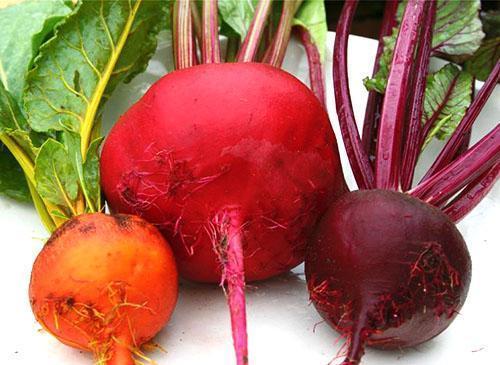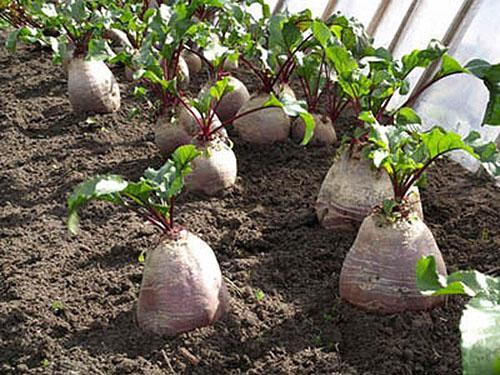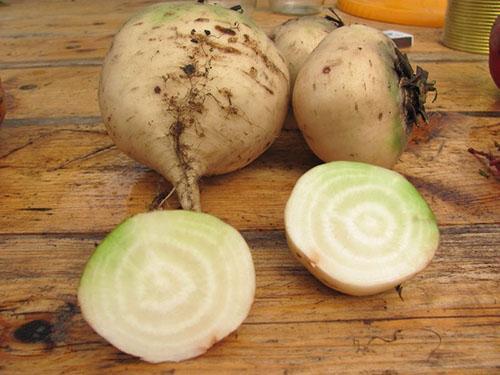What do we know about the types and varieties of beets?
 Beets (not beets!) Are a herbaceous biennial plant belonging to the Amaranth family (formerly, beets belonged to the Marevykh family). There are also annual and perennial representatives of this family. Of the 13 species included in the genus of beets, only two are grown in culture - common beets and leaf beets.
Beets (not beets!) Are a herbaceous biennial plant belonging to the Amaranth family (formerly, beets belonged to the Marevykh family). There are also annual and perennial representatives of this family. Of the 13 species included in the genus of beets, only two are grown in culture - common beets and leaf beets.
Beetroot (chard) is one-year and two-year. It does not form root crops; it has a tap or fibrous highly branched root. All the power of the plant goes into the formation of a powerful rosette of succulent leaves on thick, strong petioles.
The common beet is a biennial plant. In the first year, it forms a large fleshy root crop, and in the second year, a flower stem, on which the seeds are tied and ripen. However, common beets are usually grown in an annual crop for the sake of a tasty and healthy root crop. To obtain seeds, only small special uterine areas are left.
Common beets are divided into three subgroups:
- dining room;
- sugar;
- stern.
Table beet

 White varieties are less popular and are not even always known to the general consumer. The taste of white beets is very similar to their red cousin. It has a green leaf rosette and small elongated roots with light skin and pulp. It is used in salads, marinades, as well as in dishes where coloring of other ingredients is not desirable. The white-fruited variety “Albina Vereduna” is the most popular all over the world.
White varieties are less popular and are not even always known to the general consumer. The taste of white beets is very similar to their red cousin. It has a green leaf rosette and small elongated roots with light skin and pulp. It is used in salads, marinades, as well as in dishes where coloring of other ingredients is not desirable. The white-fruited variety “Albina Vereduna” is the most popular all over the world.
Don't confuse table white beets with sugar and fodder beets. Sugar and fodder beets also have light pulp, but are not eaten.
 Red beet varieties have a color of the pulp and skin of root crops from carmine red to maroon, almost black. Light concentric rings are clearly visible on the cross section. The shape of the root crop in red beets can be very diverse: flat, round, elongated-conical, cylindrical and spindle-shaped. Varieties with a rounded and flat root crop are the earliest, productive, good presentation. They are grown for summer consumption. Mid-season and late varieties have more elongated roots and a well-developed root system. Such root vegetables are well stored in winter.
Red beet varieties have a color of the pulp and skin of root crops from carmine red to maroon, almost black. Light concentric rings are clearly visible on the cross section. The shape of the root crop in red beets can be very diverse: flat, round, elongated-conical, cylindrical and spindle-shaped. Varieties with a rounded and flat root crop are the earliest, productive, good presentation. They are grown for summer consumption. Mid-season and late varieties have more elongated roots and a well-developed root system. Such root vegetables are well stored in winter.
Red table beets are usually subdivided into three varieties:
- Vindifolia is a group of varieties with green leaves and petioles. The petioles may be slightly pink in color. Root crops are elongated-conical in shape, with powerful roots.
- Rubrifolia - this group of varieties from the very shoots has a dark red color of leaves and roots. Fruits are quite diverse in shape: elongated-conical, round, flat. The varieties do not tolerate heat well and do not have the highest productivity.
- Atrorubra - This group includes the most common varieties of beetroot. It is characterized by dark-colored roots, bright green leaves on red or pink petioles, high productivity. The leaves have pronounced red streaks.
 The group includes the following well-known varieties:
The group includes the following well-known varieties:
- Bordeaux. It has oval or round dark red mid-season roots. Light rings on the cut are almost invisible.Leaves are erect, green, on pink petioles, reddening by autumn.
- Egyptian. Has a pronounced flat shape of root crops. They are of medium size, the color is very dark, sometimes with a purple tint. The leaves are dark green with red veins and petioles. By autumn, the red color intensifies. The varieties are usually early maturing, with few flowers.
- Eclipse. The leaves of this variety type are very similar to the Egyptian, but have a more powerful rosette and a lighter color. Root crops are oval-round and rounded, dark in color. The varieties are early ripening, with few flowers, some are drought-resistant.
- Erfurt. It combines late-ripening drought-resistant varieties. The root system is highly ramified, which makes harvesting difficult. Root crops are large, elongated-conical and cylindrical. On the cut, characteristic rings are clearly visible.
 Varieties of this type are intended for winter storage. This group includes the famous Dutch "Cillindra", which has a spindle-shaped root crop, immersed in the ground only a third of its length.
Varieties of this type are intended for winter storage. This group includes the famous Dutch "Cillindra", which has a spindle-shaped root crop, immersed in the ground only a third of its length.
 In recent years, breeders have developed new varieties of table beets: yellow and striped. These beets have retained the taste and the entire range of nutrients of the usual red beets. The advantages of these new varieties are their high decorative effect.
In recent years, breeders have developed new varieties of table beets: yellow and striped. These beets have retained the taste and the entire range of nutrients of the usual red beets. The advantages of these new varieties are their high decorative effect.
 The most famous yellow-fruited varieties are Burpee`s Golden and Golden Surprise. Of the striped varieties, the Chioggia variety is the most popular.
The most famous yellow-fruited varieties are Burpee`s Golden and Golden Surprise. Of the striped varieties, the Chioggia variety is the most popular.
In Russia, early-ripening varieties of beetroot are grown for summer consumption and mid-season varieties for winter storage. Late-ripening varieties have time to ripen only in the south of the country.
Beetroot is used fresh and after heat treatment. A wide variety of dishes are prepared from it: soups, side dishes, salads, desserts. It is boiled, stewed, baked. They are used in combination with other vegetables or as an independent dish.
 In addition to root crops, healthy beet tops are also eaten. Delicious dietary meals are prepared from it. The inclusion of beets in the daily diet helps to treat and prevent many diseases.
In addition to root crops, healthy beet tops are also eaten. Delicious dietary meals are prepared from it. The inclusion of beets in the daily diet helps to treat and prevent many diseases.
Beetroot
 Beetroot (chard, roman cabbage) is grown as an annual in culture. This plant does not tie root crops. The leaves and petioles of the aerial rosette are eaten.
Beetroot (chard, roman cabbage) is grown as an annual in culture. This plant does not tie root crops. The leaves and petioles of the aerial rosette are eaten.
Chard leaves are large, wavy, shiny, elastic, from green to dark purple in color. The petioles also come in different lengths, thicknesses and colors. The color range of the color of the petioles is truly diverse: they are deep purple, scarlet, pink, green, milky white, silver. For its high decorativeness, in some European countries, chard is even used as a flower bed.
 Chard is subdivided into two forms: petiolate and leaf. Leafy varieties, together with petioles, are used as food in salads, soups, stews. Petiolate varieties are considered the most delicious and highly prized in European restaurants. Red-peted varieties are more often used for cooked dishes, green-peted ones - for salads.
Chard is subdivided into two forms: petiolate and leaf. Leafy varieties, together with petioles, are used as food in salads, soups, stews. Petiolate varieties are considered the most delicious and highly prized in European restaurants. Red-peted varieties are more often used for cooked dishes, green-peted ones - for salads.
In Russia, the following chard varieties are best known:
- Red-peaked - "Red", "Scarlet" and "Beauty".
- Green-peted - "Green".
- Silver-stemmed - "Belavinka".
The average ripening period for leaves of beetroot is 2-2.5 months. Chard is harvested selectively by cutting off large leaves on thick stalks. With this method of collection, the plant continues to grow leaf mass. Sometimes the rosette of the chard is cut off completely. Leaves must be cut very carefully so as not to stain with earth.
Sea beet
 Another subspecies of edible beet is wild sea beet. It belongs to the leaf group. The sea beet got its name because it grows on the sea coasts close to water. It can be found in India, Africa, England, in the Crimea. Sea beet plants tolerate heat and salt saturation well, growing more than a meter in height.
Another subspecies of edible beet is wild sea beet. It belongs to the leaf group. The sea beet got its name because it grows on the sea coasts close to water. It can be found in India, Africa, England, in the Crimea. Sea beet plants tolerate heat and salt saturation well, growing more than a meter in height.
Locals eat its fresh or dried leaves.Thanks to the sea beet, which is considered the predecessor of all cultivars, ordinary table varieties are watered with saline several times per season when grown.
Sugar beet
 Sugar beet is an important industrial crop grown in large quantities for the production of sugar and ethanol. Its roots contain 8-22% sucrose. This type of beet was obtained in the 18th century by artificial selection of table varieties.
Sugar beet is an important industrial crop grown in large quantities for the production of sugar and ethanol. Its roots contain 8-22% sucrose. This type of beet was obtained in the 18th century by artificial selection of table varieties.
Sugar beet is a biennial plant, but cultivated as an annual for root crops. The mass of root crops, depending on the variety, ranges from 300 g to 3 kg. The root crop is unattractive in appearance, yellowish-white in color, white in section. The rosette of leaves is bright green.
Sugar beets are thermophilic and demanding on the soil. It grows best on black soil. The most popular varieties of German selection all over the world. In Russia, the most commonly grown varieties are "Bona", "Bohema", "Nancy", "Clarina", "Sphinx", "Mandarin".
 This type of beet, like table varieties, contains many healthy substances. Modern summer residents have recently begun to successfully master the cultivation of sugar beet on their plots. It is used as a natural sweetener in compotes, jams, baked goods, syrups, and also in salads.
This type of beet, like table varieties, contains many healthy substances. Modern summer residents have recently begun to successfully master the cultivation of sugar beet on their plots. It is used as a natural sweetener in compotes, jams, baked goods, syrups, and also in salads.
If you are going to use sugar beets in cooking, be sure to peel them, as the rind of the root vegetable tastes bad.
Fodder beet
 Fodder beet also belongs to industrial crops and is grown for feed for farm animals. Just like sugar beets, fodder beets were bred by breeders from ordinary table beets and are cultivated as annuals. In terms of composition, fodder beets almost do not differ from table beets, but they contain more protein, coarse plant fibers and fiber.
Fodder beet also belongs to industrial crops and is grown for feed for farm animals. Just like sugar beets, fodder beets were bred by breeders from ordinary table beets and are cultivated as annuals. In terms of composition, fodder beets almost do not differ from table beets, but they contain more protein, coarse plant fibers and fiber.
Root crops of fodder beets grow very large, up to several kilograms. Some specimens grew up to 30 kg.
They have a very different shape: oval, round, elongated-conical, cylindrical. The colors of root crops are no less varied: white, pink, green, yellow, orange, burgundy. The flesh on the cut is usually white, but it can also be red. Fodder beet roots do not sink into the soil, many of them grow directly on the surface, which makes harvesting easier.
 The variety of species and varieties of beets makes it one of the irreplaceable products in our life. Beetroot vegetables contain a large amount of important vitamins and minerals. Therefore, we all just need to choose a variety to our liking and settle this unpretentious vegetable in our garden.
The variety of species and varieties of beets makes it one of the irreplaceable products in our life. Beetroot vegetables contain a large amount of important vitamins and minerals. Therefore, we all just need to choose a variety to our liking and settle this unpretentious vegetable in our garden.
The beet rises and goes to the arrows what is the problem
Do not rush to plant beets. If the seeds are sown in cold soil and the sprouted or sprouted ones stay in the cold soil for 15 to 30 days, the possibility of plant shooting in the first year increases significantly. To avoid this, sow seeds after stable warm weather with a soil temperature of at least 10-12 degrees is established. C at a depth of 8-12cm. But the main reason for the ejection of arrows in beets is low-quality seeds.